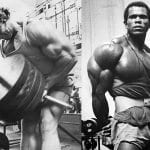This leads to a better contraction of the calves muscles and a better pump following those 30 reps. It also allows you to overload a muscle that is used to high rep work (remember your calves get a lot of work naturally throughout the day just from walking around).
4.) Using Too Heavy Weights
While lifting heavy is important to building muscle, if the weights are so big that you can’t use proper form them you won’t see much benefit. Symptoms of using too much weight include bouncing the weight at the bottom of reps, or not contracting at the top of reps.
Worse you might end up bringing other leg muscles into the exercise to help move the weight. In addition to reducing your gains training this way will also set you up for possible injury. If you feel pain in your Achilles tendon then you are definitely lifting too much weight. Similarly, if you are unable to perform standing calf raises without bending your knees, or seated calf raises without using your arms to help the weight up then you definitely need to adjust the resistance downwards.
SEE ALSO: TOP 5 Signs You’re Overtraining
5.) Only Training With Small Weights.
To look on the opposite point of view, you cannot expect results only training with light weight and high reps. Calves are one of the annoying high resistance muscle groups that require overload once in a while to grow. Your best bet? Try something between the two: heavy weight/low reps and low weight/high reps and see which gives you the best results. Most will find a combination of the two gives optimal calve growth.
6.) U only use closed chain exercises.
Closed chain exercises are those movements where the lower leg is fixed to an object or ground. Examples include straight leg calve raises and seated calve raises. Try to really hit the calves with open chain exercises, or those involving your lower leg off a fixed surface. How can you do this?
Try doing “power squats” which are very similar to a normal squat but at the end of the movement you press forcefully through the calves to leave the ground. This is done with light weight but is a great way to stress the calves in a whole new way. For those of you who are beginners or those who have known joint problems in the hip, knees, or ankles, you should try doing only closed chain until you feel you are ready for the more plyometric type exercises such as power squats.
7.) Failure to train all muscles
When you think of calves, you probably think foremost of the heart-shaped gastrocnemius muscles. Your gastrocs are the largest and most visible muscles of your lower legs, but the soleus beneath and below the gastroc also needs to be fully taxed, as do the flexor muscles on your shins, foremost the tibialis anterior. These small shin muscles are not going to wow anyone, but they do set off your calves when viewed from the front, and strengthening them guards against shin splits (a common injury for runners).


